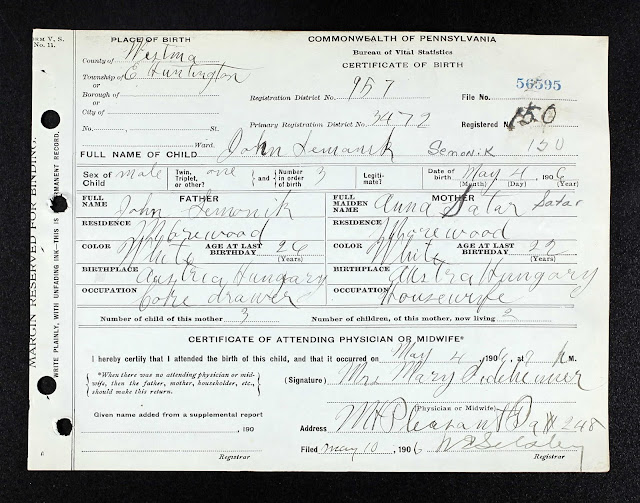 |
| The first of three sons named John, born to John and Anna Simonik, who born and died in 1906. |
I am occasionally participating in 52 Ancestors in 52 Weeks, a writing challenge encouraging genealogy researchers to write about their ancestors. The challenge is hosted by genealogist, blogger and podcaster Amy Johnson Crow.
This week's prompt: Same Name
By Nancy Gilbride Casey
In my search through Pennsylvania birth and death records on
Ancestry, I was puzzled to find certificates for several sons born to my Slovak great grandparents John and Anna Simonik.
I had not known about these children. Since the babies were either stillborn or died shortly after birth, the knowledge of these sad events was likely not passed down through the family. In fact, I am not sure my grandmother, Margaret Simonik Kozlina, knew that she had three brothers who had not survived to adulthood.
Interestingly, all of these sons were named
John on their certificates. The first, stillborn in 1906, was no doubt named after his father John. But why the others?
Giving a newborn the
same name of a dead relative—called a
necronym—was a common practice until the late nineteenth century among Americans and Europeans. In a time of high birth rates—but also high infant mortality—if a child died in infancy, his or her name was often given to the next child.
1 The word necronym derives from the Greek νεκρός, nekros, "dead" and ὄνομα ónoma, "name"
2
 |
| A second son was given the necronym of John in 1920, named after his older brother who died. |
 |
| A last son was named John in 1922, but he too, passed away. The name was not used again. |
While in some cultures, using the name of the dead is considered taboo, for others it is a way to honor the dead. A query posed on the
Slovak Genealogy / slovenské genealógie Facebook page regarding the practice in Slovak culture (and others), brought these responses and examples from members:
3
One wrote, "Folks in the entire region used this practice. My Ukrainian side from southeast Poland has an older brother changing his name to his baby brother who died; a mother changing her name to a daughter who died; and an older brother named after his infant brother who had died."
Another wrote:
"My maternal grandmother had 16 children between 1906 and 1931. Three died as infants, one in her teens, and four of her later children were given their names."
"My grandfather's first son has named Joseph after him. He died. Then the next son was named Joseph. He died. After about four children his daughter was named Josefina. She died in the flu epidemic. And after two more children he had a son named Joseph. He lived," shared another.
Hearing these examples got me wondering if my own mother may have benefited from this practice as well. Christened Anna Margaret Kozlina, she was born in 1937. Her aunt, Anna Simonik, was my grandmother's older sister who died in 1933 of encephalitis lethargica—sleeping sickness. Grandma and her sister, Anna, were very close, working as laundresses at the same hospital together in Beaver Falls, Pennsylvania before Grandma married. Could Grandma have named Mom after her beloved late sister in order to honor her? Although I will never know, it seems possible.
What about you? Do you have family members who share the same name? Let me know in the comments.
Until next time...
Subscribe to "Leaves on the Tree," to receive more family history stories, right in your email box. Click the green Subscribe link above.
NOTES
1 Jeannie Vanasco, The Believer (http://bit.ly/2OufzA3 : accessed 5 Feb 2020), "What's in a Necronym?"
2 Wikipedia (https://en.wikipedia.org : accessed 5 Feb 2020), "Necronym," rev. 19:55, 2 January 2019.
3 Used with permission of the posters.



Comments
Post a Comment